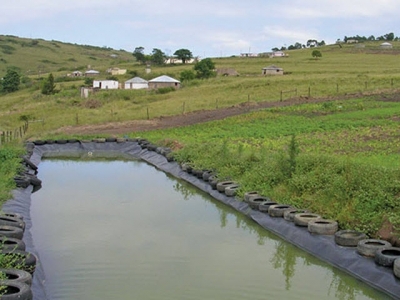How to start your own aquaculture business – Part 3

Before embarking on a project, have a practical and sensible understanding of the funds and skills available to you. Do your research before identifying partners, mentors and an appropriate system.
Conversely, expectations of fish production obtained from this level of technology have to be realistic – it will be low. Photo: Nicholas James
In the last two articles, we examined the road to be taken by starter fish farmers with little or no experience.
We have acquainted ourselves with the basics of tilapia biology, looked at system design options that are relevant to the site under consideration, and understood the fact that marketing is, in fact, not a major stumbling block. Now, where to from here?
The desired scale of any project has to be in proportion to the likely funding available and the skills on hand – and whether these are actually or theoretically available.
It is a misconception to believe that skilled, practical fish farmers can simply be hired through an employment agency, to run a project from inception to production stage.
Whilst universities and colleges do indeed produce numbers of graduates who have the theoretical skills, these skills are often based on limited practical experience carried out under research conditions where the cost of the practical work is borne by the institution.
In addition, the success or failure that is achieved before a result can be ‘written up’ does not take into consideration any economics along the way.
In other words, it is all very well to learn about the wonders of ozone sterilisation, foam fractionalisation, bio-floc filtration, or the production of genetically all-male YY-chromosome fish, but the applicable relevance of these new technologies must also be understood. That can be summed up in one word: ‘experience’.
Realism is the watchword
I often smile when I read about some new start-up project that has employed a bright new ‘kid-on-the-block’ bursting with revolutionary new technical ideas that will show us old dinosaurs what we did wrong. Such projects invariably start up in a fanfare of publicity, only to die an inconspicuous death some time later.
The important thing is to gain a realistic idea of what is possible, economical, viable, practical and sensible – before investing. There is nothing wrong with experimenting with the glitz and glamour technologies once a modicum of success has been achieved with the basic rearing and harvesting of fish under tried-and-tested methodologies, but to do so at start-up level is inviting disaster.
How many times have we heard of projects that claim a monthly anticipated production of 100t per month, only to barely achieve this in a year? Realism and a cautious approach will usually win the day.
What is their track record?
Having been brought back to earth in one’s aspirations, the next step is to identify partners, mentors, trainers, and technical design help.
The fundamental here is track record. If a design appears to be appealing, or you are tempted by the sales pitch of the consultant, check out his history of success. Anyone who claims to have been a consultant for 10 years or longer should have a folder of achievements behind him. If the answer – or excuse – seems to be, “Well, the client didn’t want to listen…” warning bells should sound!
Có thể bạn quan tâm
 How to start your own aquaculture business -part 1
How to start your own aquaculture business -part 1 In this new series, Nicholas James will provide prospective tilapia farmers with a step-by-step guide on how to launch and run a successful aquaculture business
 Seaweed supplementation said to boost immunity in fish
Seaweed supplementation said to boost immunity in fish Adding supplemental seaweed to farmed fish diets could boost immune functioning and antioxidant responses.
 How to start your own aquaculture business – part 2
How to start your own aquaculture business – part 2 In this second instalment of our series on launching an aquaculture business, we look at what steps to follow once a beginner has secured a basic knowledge